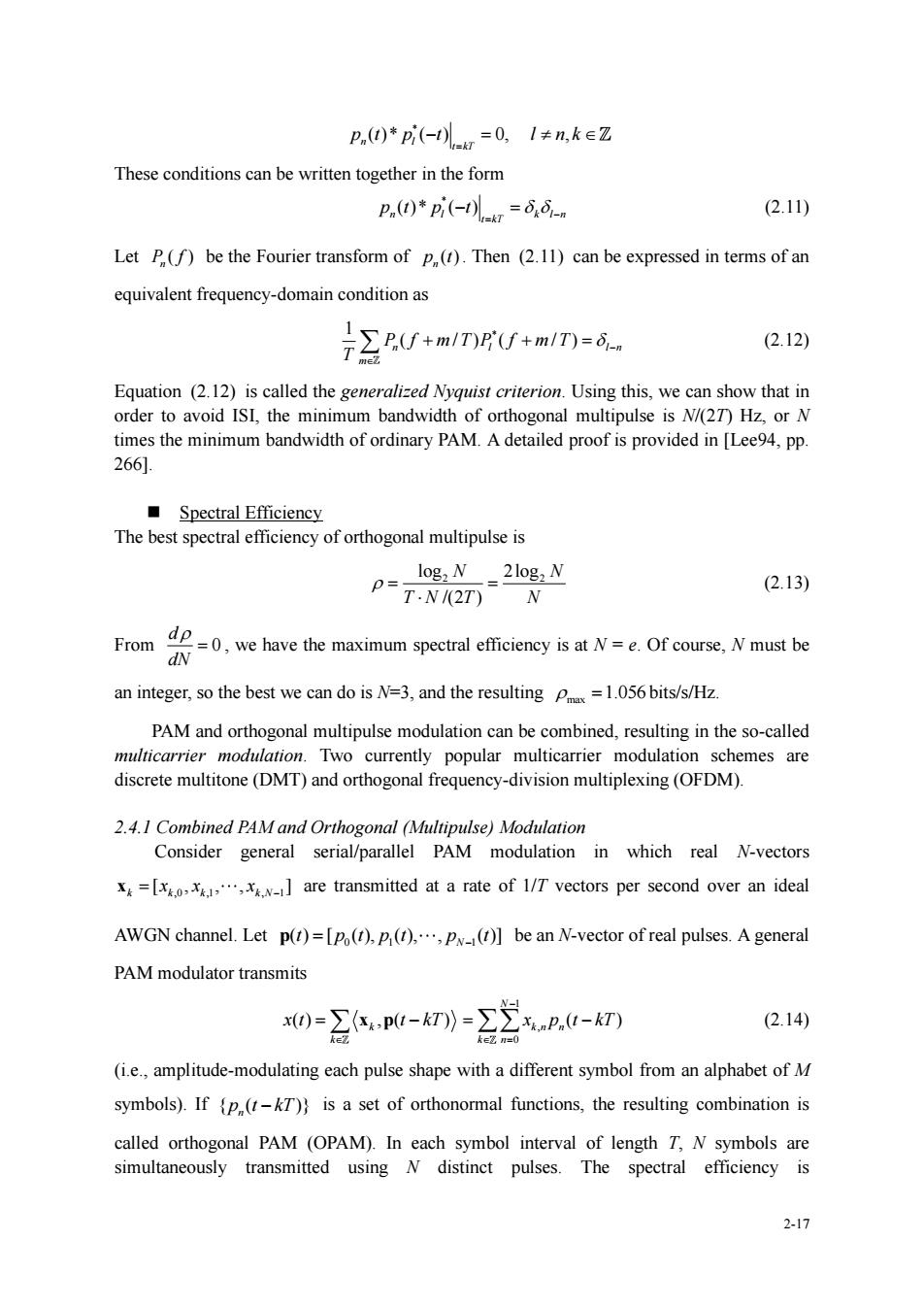正在加载图片...

p.)*pi(-g=0,1≠n,keZ These conditions can be written together in the form P.(1)*Pi(-1)=6 (2.1) Let P(f)be the Fourier transform of p().Then (2.11)can be expressed in terms of an equivalent frequency-domain condition as (2.12) Equation (2.12)is called the generalized Nyquist criterion.Using this,we can show that in order to avoid ISI,the times the minimum bandwidth of ordinary PAM.A detailed proof is provided in [Lee94.pp. 2661. ■Spectral Efficiency The best spectral efficiency of orthogonal multipulse is log,N p=T-N2D)N (2.13) we have the maximum speetral efficieney is t NeOfcourse Nmust be From dp】 an integer,so the best we can do is N=3,and the resultingP=1.056bits/s/Hz. PAM and orthogonal multipulse modulation can be combined,resulting in the so-called multicarrier modulation.Two currently popular multicarrier modulation schemes are discrete multitone(DMT)and orthogonal frequency-division multiplexing(OFDM). 2.4.1 Combined PAM and Orthogonal (Multipulse)Modulation Consider general serial/parallel PAM modulation in which real N-vectors =[are transmitted at a rate of l/T vectors per second over an ideal AWGN channel.Let p(r)=[p(t).p().P()]be an N-vector of real pulses.A general PAM modulator transmits 0=,pu-k灯)=Σp.-k灯 (2.14) (i amplitude-modulating each pulse shape with a different symbol from an alphabet ofM symbols).Ifp(k is a set of orthonormal functions,the resulting combination is called orthogonal PAM (OPAM).In each symbol interval of length T,N symbols are simultaneously transmitted using N distinct pulses.The spectral efficiency is 2-172-17 * ( )* ( ) 0, , n l t kT p t p t l n k = − = These conditions can be written together in the form * ( )* ( ) n l k l n t kT p t p t − = − = (2.11) Let ( ) P f n be the Fourier transform of ( ) n p t . Then (2.11) can be expressed in terms of an equivalent frequency-domain condition as 1 * ( / ) ( / ) n l l n m P f m T P f m T T − + + = (2.12) Equation (2.12) is called the generalized Nyquist criterion. Using this, we can show that in order to avoid ISI, the minimum bandwidth of orthogonal multipulse is N/(2T) Hz, or N times the minimum bandwidth of ordinary PAM. A detailed proof is provided in [Lee94, pp. 266]. ◼ Spectral Efficiency The best spectral efficiency of orthogonal multipulse is 2 2 log 2log /(2 ) N N T N T N = = (2.13) From 0 d dN = , we have the maximum spectral efficiency is at N = e. Of course, N must be an integer, so the best we can do is N=3, and the resulting max =1.056 bits/s/Hz. PAM and orthogonal multipulse modulation can be combined, resulting in the so-called multicarrier modulation. Two currently popular multicarrier modulation schemes are discrete multitone (DMT) and orthogonal frequency-division multiplexing (OFDM). 2.4.1 Combined PAM and Orthogonal (Multipulse) Modulation Consider general serial/parallel PAM modulation in which real N-vectors ,0 ,1 , 1 [ , , , ] k k k k N x x x = − x are transmitted at a rate of 1/T vectors per second over an ideal AWGN channel. Let 0 1 1 ( ) [ ( ), ( ), , ( )] N t p t p t p t p = − be an N-vector of real pulses. A general PAM modulator transmits ( ) , ( ) k k x t t kT = − x p 1 , 0 ( ) N k n n k n x p t kT − = = − (2.14) (i.e., amplitude-modulating each pulse shape with a different symbol from an alphabet of M symbols). If { ( )} n p t kT − is a set of orthonormal functions, the resulting combination is called orthogonal PAM (OPAM). In each symbol interval of length T, N symbols are simultaneously transmitted using N distinct pulses. The spectral efficiency is